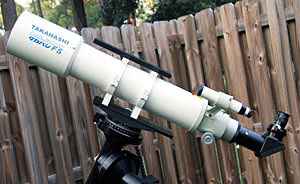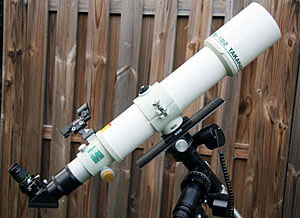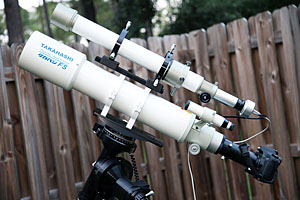 FS-102 on G-11 |
 TSA-102 on GM-8 |
 FS-102 set up for imaging |
Comparison Viewing and Imaging Performance Between the Takahashi TSA-102 and FS-102
After running tests with the three refractors listed in the main review (Vixen ED100SF, TV 102, TSA-102S), I got a chance to compare performance between the TSA-102S and a FS-102 (FS-102NSV).
Fluorite doublet 4-inch refractors are renowned for their bright, high-contrast, sharp optical performance and retain high resale value on the used telescope market. Takahashi used to tout "The Fluorite Advantage" in the FS series advertisements. Fluorite glass has high light transmission with excellent color correction. The FS-102 is an air-spaced double with fluorite element in front of a crown flint glass element. It was manufactured by Takahashi from 1994 through 2005 or 2006. It was replaced in 2006 by the TSA-102 which has an air-spaced triplet that uses ED FPL-53 glass instead of a fluorite element. The FS-102NSV was the final version of the FS-102 line that was manufactured starting in 2005. It has a shorter main optical tube with an extension tube on the focuser so that it can be used with binoviewers and so that it can also be more compact for transport. It also has a retractable dewshield that makes it even more compact for transport and storage than the original FS-102.
From September 13 through 15, 2011, I compared planetary viewing performance on Jupiter and binary star viewing on Struve 2107 with my TSA-102S and a mint condition FS-102NSV that I purchased used on Astromart. Comparisons were made using Astro-Physics Max Bright diagonals and
Pentax 5mm XO and University Optics 4mm Abbe Ortho eyepieces on both telescopes. Planetary views were also compared using a
William Optics Binoviewer with Tele Vue 8mm Plossl eyepieces and 1.6X Barlow lens. No differences were noted viewing the binary star Stuve 2107 in Hercules that has approximately 1.8 arcseconds separation with the Pentax 5mm XO. Both the TSA-102S and the FS-102NSV provided views of clear separation of the binary stars.
Comparison viewing of Jupiter was done early in the morning under very stable, excellent viewing conditions. Both telescope provided high quality planetary viewing performance. I was unable to see any difference in planetary detail when viewing with the 5mm eyepiece or with the binoviewer at 164X magnification. Excellent detail was provided of Northern and Southern equatorial bands as well as finer band detail in Northern and Southern temperate regions. However, I did see consistent small differences when viewing with the 4mm eyepiece at 205X magnification. The FS-102 provided slightly more detailed and higher contrast planetary detail than the TSA-102, especially when observing fine detail in the Southern and northern temperate regions. Light scatter patterns when viewing Jupiter with the two telescopes were indistinguishable.
One of the features I like about the TSA-102 is that it makes a good astrograph when used with the TOA-35 flattener and a APS digital SLR camera or a small chip CCD (e.g., SBIG ST-10XME). So I also compared imaging performance of using a Canon APS camera (EOS-40D and EOS-7D) with both telescopes and the TOA-35 flattener. The TSA-102S / TOA-35 flattener combination produced focused, round stars from the center to the edge of the field with a Canon EOS-40D camera. The FS-102 did not perform as well with the TOA-35 flattener and Canon EOS-7D. Stars in the center of the field were sharp and round (Different night and different target). However, stars at the edges of the field (10-15%), were oval shaped. This suggests that either field curvature or astigmatism were problems with the FS-102 / TOA-35 combination for astrophotography.
Conclusions:
The TSA-102S and FS-102 give closely comparable planetary and binary star viewing performance. At high magnification (i.e., 205X), the FS-102 gives slightly sharper and higher contrast views than the TSA-102. When used for astrophotography with a TOA-35 flattener and Canon APS-C sensor camera (e.g., EOS-40D or EOS-7D), the TSA-102 /TOA-35 flattener gives better round star performance out to the edge of the field than the FS-102 / TOA-35 combination.
4 inch Refractor Comparison: Review of Takahashi TSA-102S, Tele Vue 102 and Vixen ED100SF